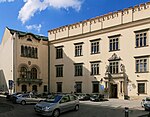St. Andrew's Church, Kraków

The Church of St. Andrew in the Old Town district of Kraków, Poland (Polish: Kościół św. Andrzeja) located at Grodzka Street, is a historical Romanesque church built between 1079 and 1098 by a medieval Polish statesman Palatine Sieciech. It is a rare surviving example of the European fortress church used for defensive purposes. Built in Romanesque style, it is one of the oldest buildings in Kraków and one of the best-preserved Romanesque buildings in Poland. It was the only church in Kraków to withstand the Mongol attack of 1241. Along the lower part of the broader section of its façade are small openings that served as defensive windows at a time when the church was a place of refuge from military assaults. From 1320 it was used by the Religious Order of Poor Clares. The building has been renovated many times. The present Baroque interiors have decorations by Baltazar Fontana, paintings by Karol Dankwart and gilded altars. The Baroque domes atop the octagonal towers were added in 1639.
Excerpt from the Wikipedia article St. Andrew's Church, Kraków (License: CC BY-SA 3.0, Authors, Images).St. Andrew's Church, Kraków
Józefa Dietla, Krakow Stare Miasto (Old Town)
Geographical coordinates (GPS) Address Nearby Places Show on map
Geographical coordinates (GPS)
| Latitude | Longitude |
|---|---|
| N 50.056666666667 ° | E 19.938611111111 ° |
Address
Historyczne centrum Krakowa
Józefa Dietla
31-073 Krakow, Stare Miasto (Old Town)
Lesser Poland Voivodeship, Poland
Open on Google Maps











